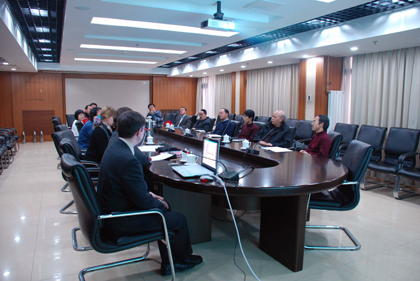Russian Scholars Delivered Lecture at the Institute of Archaeology, CASS
On December 10, 2009, at 14:00, two scholars from the Institute of Archaeology, Russian Academy of Sciences, Ekaterinka E. Devlet and Irina V. Rukavishnikova delivered two academic lectures at the Institute of Archaeology, Chinese Academy of Social Sciences. These lectures were hosted by Professor Chen Xingcan, translated by Zhang Liangren, and attended by researchers and graduates of the institute.

Professor Ekaterina Devlet, Scientific Secretary of the IARAS, first gave a general introduction of the institute and its field and laboratory projects in the recent years with the title of “Major Fields of Investigation of the Institute of Archaeology, Russian Academy of Sciences,”
Dr. Irina Rukavishnikova followed up with the first lecture “Scythian-Siberian Animal Motifs.” Apart from typological analysis of animal motifs from the Filippovka Kurgan in the South Urals, she studies the chronology, technique, and semantic of comparable animal motifs found in various regions across the Eurasian steppes. For this purpose, she builds up a database of animal motifs of the Scythian period from Caucasus to Mongolia. The Filippovka Kurgan yielded 135 animal motifs, which she subjects to typological, functional, and material analyses. As a result she traces their origins to three regions, Altai-Tuva, Central Asia, and Caucasus, which had extensive interactions with the South Urals.
Professor Ekaterina Devlet presented her own research in “Rock Arts in Russia.” She first gave an overview of rock arts in Russia, stressing that there are various traditions in various regions. She then described the research methods of rock art. Taking those in Chukotka Autonomous Region in Far East as example, she explains how she documents rock arts and replicates them. Through microscopic observation, she discovers that some pieces were carved with modern steel tools, which corrects the previous dating of the Neolithic Age. She also uses a German-made resin to replicate rock arts to be exhibited in museums.
Attendees of this event, who were experienced with foreign and frontier archaeologies, took great interest in the two academic lectures. In the succeeding discussion session, they interacted with the Russian scholars on the origin of animal motifs, methods of rock art making, dates of particular rock art motifs, and origin of bronze cauldrons. An iron armor from the Filippovka Kurgan in particular aroused an in-depth discussion on the origin of armor in China and Russia. (Translated by Zhang Liangren)

